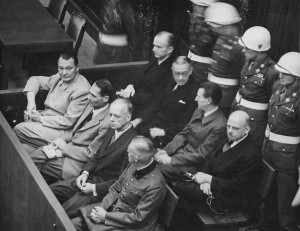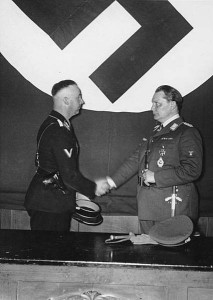 The legacy of the Nazi Party and the Third Reich is one of violence and cruelty. While there have been all manner of tyrannical dictators throughout human history, few are as reviled or well known as Adolph Hitler.
The legacy of the Nazi Party and the Third Reich is one of violence and cruelty. While there have been all manner of tyrannical dictators throughout human history, few are as reviled or well known as Adolph Hitler.
Hitler needed a large amount of support to realize his ideas and among the most feared of his loyalists were the German Gestapo, his secret police. The group was charged with rooting out all internal opposition that threatened Hitler and the Nazi Party.
The Gestapo
The term “Gestapo” is a shorted form of “Geheime Staatspolizei,” which means ”Secret State Police.” The loyalty of this police force was not directed at people or the public good, but to Hitler’s increasingly oppressive fascist regime. As the name of the police force indicates, its responsibilities revolved around serving the state and destroying its internal enemies.
The Fire Decree and the Enabling Act of 1933 had suspended many rights, including Habeas Corpus. As the state grew increasingly oppressive, it was to be expected that rebellion and resistance would answer its expanding restraint. The Gestapo’s main directive was to locate these factions and deal with them accordingly.
The Origin
While the Gestapo reported to Hitler, he was not the person that originally established the force. Rather, it was the high ranking Nazi official, Hermann Göring, who first had the idea. Göring came to power when Hitler instated him as the Prussian Interior Minister, giving him command of an incredibly massive police force. Göring very quickly filled the ranks with Nazis, ensuring that the police would be loyal to him and Hitler. In particular, the political and internal intelligence wings of the police force were comprised almost exclusively of Nazis. Göring eventually merged the political and the intelligence divisions together on April 26, 1933, with the new unit being called the Gestapo.
The Power Struggles in the Gestapo
There existed power struggles among the different Nazi Party officials at the time of the Gestapo’s instatement. Heinrich Himmler, for one, was involved heavily with the police force in Bavaria and felt his power was being minimized by Göring. There were also many concerns over the official Commander of the Gestapo, Rudolf Diels. It was deemed that he did not possess a sufficient level of ruthlessness to use the Gestapo as intended. Eventually, Himmler would become the Chief of all Police outside of Prussia. As one of his first moves, he would name Reinhard Heydrich the new Commander of the Gestapo.
Regardless of the many different power struggles that occurred among his subordinates, Hitler knew he had their loyalty. The leaders of the Gestapo would become some of the most powerful figures in Germany. They would also quickly become some of the most feared.
The Elimination of Judicial Review
Almost immediately after being elected, Hitler was able to assume dictatorial power in Germany. He was no longer constrained by the parliament and could enact laws on his own without their approval. To consolidate his power, he removed many of the checks and balances from those entities that served him. One way this was achieved was through removing judicial review from the Gestapo. In short, the Gestapo only had to answer to Hitler and were not affected by the law. This allowed Hitler to use them as agents of domestic terror. Needless to say, this made the populace more fearful of the police force and less willing to oppose the Nazi Party.
The specific tasks of the Gestapo were to protect the Nazi Party from acts of espionage and treason. So, the Gestapo could not really be called a German police force as much as the tool of one party.
The Structure of the Gestapo
The Gestapo did not consist of a single entity. Like any other police force, there were divisions tasked with specific goals and responsibilities. Departments of the Gestapo were listed from A to E, with each of them in its own area of responsibility. Department A dealt with political opponents of the Nazi Party and the State. Department B oversaw sects and churches. Department C was somewhat of an internal affairs division dealing with party and administration affairs. Department D had jurisdiction over occupied territories. Department E centered on counterintelligence.
Joining
 The bulk of the Gestapo came from the police forces. While Hitler and the Nazis dissolved various governments they felt were disloyal, select preexisting police forces were not disbanded. Party loyalty was not always demanded of those police officers in low level ranks of the Gestapo, the reason for this being that certain police and civil servant skills were required for the Gestapo to function. Therefore, technocratic, bureaucratic and police skills were highly valued when hiring lower level Gestapo members.
The bulk of the Gestapo came from the police forces. While Hitler and the Nazis dissolved various governments they felt were disloyal, select preexisting police forces were not disbanded. Party loyalty was not always demanded of those police officers in low level ranks of the Gestapo, the reason for this being that certain police and civil servant skills were required for the Gestapo to function. Therefore, technocratic, bureaucratic and police skills were highly valued when hiring lower level Gestapo members.
Opposition
There was a large amount of opposition to the Gestapo, most of which came from college campuses. Such activities were quickly suppressed, with their organizers dealt with brutally. Very few continued to challenge the Gestapo.
The Fall of Hitler and the Gestapo
At the end of World War II, Hitler committed suicide in his bunker. His government officials were persecuted in the Nuremberg trials, and the Gestapo was condemned as a criminal organization.
